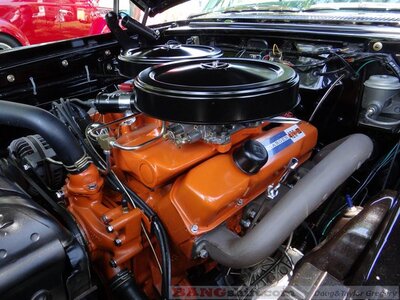Interesting. 400 horse is disappointing but nick mentioned only 165# cyl. pressure.
Last edited:
I thought so too. Looking for the specs, but a buddy put together a mild hydraulic cam/ported heads 440 and got close to 500 horse and darned near as much torque.Long duration cam is clearly hurting the HP manifolds. I would like to see the difference with a more friendly cam like the Mopar .528
Exactly! Chrysler engineers had it going back then. And the Max Wedge exhaust system was cool as well.Interesting test.
H.P. Exhaust Manifolds: 380 HP and 398 TQ
Max Wedge Exhaust Manifolds: 414 HP and 449 TQ
Headers: 418 HP and 465 TQ
What surprised me is how good the Max Wedge exhaust manifolds were - almost equal to headers!
But......headers don't make power...the engineers designed the engines and manifolds to work within cost and maintenance constraints to make the best power....
 Headers still make more power even on a stock engine, although the differences aren't as large.
Headers still make more power even on a stock engine, although the differences aren't as large.I wanted a set of Max Wedge manifolds for a long time now. I actually could have bought a set for around $500. about 7 years ago. I wish I had the money then and bought them. There are several reasons why I wanted them but hesitated too long and lost out. First, I love the way they look. Second, and most importantly, they open up a lot of space down the sides of the engine so it appeared that access to the starter and steering box and such was improved. Third, the plug wires run below them avoiding some of the rising heat. Forth, they were cast iron and most likely last a lot longer than steel headers. On the down side, I thought the collector flange had two openings, not one and obviously I was wrong. The big reason I hesitated, was I read somewhere that you couldn't use them on a street car with a dual master cylinder due to the closeness of the manifold to it. Whether it would hit it,(depending on body) was one thing, but the heat was supposed to boil your brake fluid. I recall asking if you could make a shield between the the manifold and the master cylinder and was told there generally wasn't room unless you use a single master cylinder. Can anyone confirm the boiling brake fluid ??I have only seen pictures, never in real life, and they are incredibly rare. I dont believe five grand would buy a pair.
Edit : Just checked, Ten grand wont buy a pair!
Well I simply typed "Max Wedge" into google and looked at the photos. I haven't seen any dual reservoirs yet. All of them look like this:I wanted a set of Max Wedge manifolds for a long time now. I actually could have bought a set for around $500. about 7 years ago. I wish I had the money then and bought them. There are several reasons why I wanted them but hesitated too long and lost out. First, I love the way they look. Second, and most importantly, they open up a lot of space down the sides of the engine so it appeared that access to the starter and steering box and such was improved. Third, the plug wires run below them avoiding some of the rising heat. Forth, they were cast iron and most likely last a lot longer than steel headers. On the down side, I thought the collector flange had two openings, not one and obviously I was wrong. The big reason I hesitated, was I read somewhere that you couldn't use them on a street car with a dual master cylinder due to the closeness of the manifold to it. Whether it would hit it,(depending on body) was one thing, but the heat was supposed to boil your brake fluid. I recall asking if you could make a shield between the the manifold and the master cylinder and was told there generally wasn't room unless you use a single master cylinder. Can anyone confirm the boiling brake fluid ??

The ones i was referring to were the tri-ys, which did have a double exhaust exit, unlike the normal maxwedge exhausts.I wanted a set of Max Wedge manifolds for a long time now. I actually could have bought a set for around $500. about 7 years ago. I wish I had the money then and bought them. There are several reasons why I wanted them but hesitated too long and lost out. First, I love the way they look. Second, and most importantly, they open up a lot of space down the sides of the engine so it appeared that access to the starter and steering box and such was improved. Third, the plug wires run below them avoiding some of the rising heat. Forth, they were cast iron and most likely last a lot longer than steel headers. On the down side, I thought the collector flange had two openings, not one and obviously I was wrong. The big reason I hesitated, was I read somewhere that you couldn't use them on a street car with a dual master cylinder due to the closeness of the manifold to it. Whether it would hit it,(depending on body) was one thing, but the heat was supposed to boil your brake fluid. I recall asking if you could make a shield between the the manifold and the master cylinder and was told there generally wasn't room unless you use a single master cylinder. Can anyone confirm the boiling brake fluid ??
